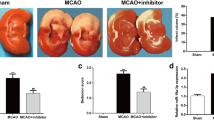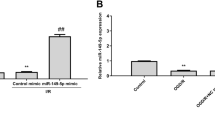Abstract
MicroRNA-25 (miR-25) has been reported to be a major miRNA marker in neural cells and is strongly expressed in ischemic brain tissues. However, the precise mechanism and effect of miR-25 in cerebral ischemia/reperfusion (I/R) injury needs further investigations. In the present study, the oxygen-glucose deprivation (OGD) model was constructed in human SH-SY5Y and IMR-32 cells to mimic I/R injury and to evaluate the role of miR-25 in regulating OGD/reperfusion (OGDR)-induced cell apoptosis. We found that miR-25 was downregulated in the OGDR model. Overexpression of miR-25 via miRNA-mimics transfection remarkably inhibited OGDR-induced cell apoptosis. Moreover, Fas was predicted as a target gene of miR-25 through bioinformatic analysis. The interaction between miR-25 and 3′-untranslated region (UTR) of Fas mRNA was confirmed by dual-luciferase reporter assay. Fas protein expression was downregulated by miR-25 overexpression in OGDR model. Subsequently, the small interfering RNA (siRNA)-mediated knockdown of Fas expression also inhibited cell apoptosis induced by OGDR model; in contrast, Fas overexpression abrogated the protective effects of miR-25 on OGDR-induced cells. Taken together, our results indicate that the upregulation of miR-25 inhibits cerebral I/R injury-induced apoptosis through downregulating Fas/FasL, which will provide a promising therapeutic target.









Similar content being viewed by others
Abbreviations
- OGD:
-
Oxygen-glucose deprivation
- OGDR:
-
Oxygen-glucose deprivation/reperfusion
- UTR:
-
Untranslated region
- miR-25:
-
microRNA-25
References
Amiri E, Ghasemi R, Moosavi M (2015) Agmatine protects against 6-OHDA-induced apoptosis, and ERK and Akt/GSK disruption in SH-SY5Y Cells. Cell Mol Neurobiol
Bartel DP (2004) MicroRNAs: genomics, biogenesis, mechanism, and function. Cell 116(2):281–297
Bien K, Sokolowska J, Baska P, Nowak Z, Stankiewicz W, Krzyzowska M (2015) Fas/FasL pathway participates in regulation of antiviral and inflammatory response during mousepox infection of lungs. Mediators Inflamm 2015:281613
Chan FK, Chun HJ, Zheng L, Siegel RM, Bui KL, Lenardo MJ (2000) A domain in TNF receptors that mediates ligand-independent receptor assembly and signaling. Science 288(5475):2351–2354
Chen HC, Kanai M, Inoue-Yamauchi A et al (2015) An interconnected hierarchical model of cell death regulation by the BCL-2 family. Nat Cell Biol 17(10):1270–1281
Garcia S, Conde C (2015) The role of poly(ADP-ribose) polymerase-1 in rheumatoid arthritis. Mediators Inflamm 2015:837250
Go AS, Mozaffarian D, Roger VL et al (2013) Executive summary: heart disease and stroke statistics—2013 update: a report from the American Heart Association. Circulation 127(1):143–152
Guo F, Han X, Zhang J et al (2014) Repetitive transcranial magnetic stimulation promotes neural stem cell proliferation via the regulation of MiR-25 in a rat model of focal cerebral ischemia. PLoS One 9(10):e109267
Guo X, Chi S, Cong X et al (2015) Baicalin protects sertoli cells from heat stress-induced apoptosis via activation of the Fas/FasL pathway and Hsp72 expression. Reprod Toxicol 57:196–203
Henkart PA, Williams MS, Zacharchuk CM, Sarin A (1997) Do CTL kill target cells by inducing apoptosis? Semin Immunol 9(2):135–144
Huang W, Liu X, Cao J et al (2015) miR-134 regulates ischemia/reperfusion injury-induced neuronal cell death by regulating CREB signaling. J Mol Neurosci 55(4):821–829
Jeyaseelan K, Lim KY, Armugam A (2008) MicroRNA expression in the blood and brain of rats subjected to transient focal ischemia by middle cerebral artery occlusion. Stroke 39(3):959–966
Lim LP, Lau NC, Garrett-Engele P et al (2005) Microarray analysis shows that some microRNAs downregulate large numbers of target mRNAs. Nature 433(7027):769–773
Liu P, Zhao H, Wang R et al (2015) MicroRNA-424 protects against focal cerebral ischemia and reperfusion injury in mice by suppressing oxidative stress. Stroke 46(2):513–519
Mendell JT, Olson EN (2012) MicroRNAs in stress signaling and human disease. Cell 148(6):1172–1187
Pan L, Huang BJ, Ma XE et al (2015) MiR-25 protects cardiomyocytes against oxidative damage by targeting the mitochondrial calcium uniporter. Int J Mol Sci 16(3):5420–5433
Pei H, Song X, Peng C et al (2015) TNF-alpha inhibitor protects against myocardial ischemia/reperfusion injury via Notch1-mediated suppression of oxidative/nitrative stress. Free Radic Biol Med 82:114–121
Peng G, Yuan X, Yuan J et al (2015) miR-25 promotes glioblastoma cell proliferation and invasion by directly targeting NEFL. Mol Cell Biochem 409(1-2):103–111
Porter AG, Janicke RU (1999) Emerging roles of caspase-3 in apoptosis. Cell Death Differ 6(2):99–104
Ramaswamy M, Cleland SY, Cruz AC, Siegel RM (2009) Many checkpoints on the road to cell death: regulation of Fas-FasL interactions and Fas signaling in peripheral immune responses. Results Probl Cell Differ 49:17–47
Salakou S, Kardamakis D, Tsamandas AC et al (2007) Increased Bax/Bcl-2 ratio up-regulates caspase-3 and increases apoptosis in the thymus of patients with myasthenia gravis. In Vivo 21(1):123–132
Saravanan PB, Shanmuganathan MV, Ramanathan M (2015) Telmisartan attenuated LPS-induced neuroinflammation in human IMR-32 neuronal cell line via SARM in AT1R independent mechanism. Life Sci 130:88–96
Stary CM, Xu L, Sun X et al (2015) MicroRNA-200c contributes to injury from transient focal cerebral ischemia by targeting reelin. Stroke 46(2):551–556
Trauth BC, Klas C, Peters AM et al (1989) Monoclonal antibody-mediated tumor regression by induction of apoptosis. Science 245(4915):301–305
Vafaiyan Z, Gharaei R, Asadi J (2015) The correlation between telomerase activity and Bax/Bcl-2 ratio in valproic acid-treated MCF-7 breast cancer cell line. Iran J Basic Med Sci 18(7):700–704
Vivier E, Tomasello E, Baratin M, Walzer T, Ugolini S (2008) Functions of natural killer cells. Nat Immunol 9(5):503–510
Wang Z, Wang Y, Ye J et al (2015) bFGF attenuates endoplasmic reticulum stress and mitochondrial injury on myocardial ischaemia/reperfusion via activation of PI3K/Akt/ERK1/2 pathway. J Cell Mol Med 19(3):595–607
Winter J, Jung S, Keller S, Gregory RI, Diederichs S (2009) Many roads to maturity: microRNA biogenesis pathways and their regulation. Nat Cell Biol 11(3):228–234
Yellon DM, Hausenloy DJ (2007) Myocardial reperfusion injury. N Engl J Med 357(11):1121–1135
Yonehara S, Ishii A, Yonehara M (1989) A cell-killing monoclonal antibody (anti-Fas) to a cell surface antigen co-downregulated with the receptor of tumor necrosis factor. J Exp Med 169(5):1747–1756
Yu HC, Qin HY, He F et al (2011) Canonical notch pathway protects hepatocytes from ischemia/reperfusion injury in mice by repressing reactive oxygen species production through JAK2/STAT3 signaling. Hepatology 54(3):979–988
Yu HC, Bai L, Yue SQ et al (2013) Notch signal protects non-parenchymal cells from ischemia/reperfusion injury in vitro by repressing ROS. Ann Hepatol 12(5):815–821
Zhao H, Tao Z, Wang R et al (2014a) MicroRNA-23a-3p attenuates oxidative stress injury in a mouse model of focal cerebral ischemia-reperfusion. Brain Res 1592:65–72
Zhao H, Wang Y, Yang L, Jiang R, Li W (2014b) MiR-25 promotes gastric cancer cells growth and motility by targeting RECK. Mol Cell Biochem 385(1-2):207–213
Zhao Y, Deng B, Li Y et al (2015) Electroacupuncture pretreatment attenuates cerebral ischemic injury via notch pathway-mediated Up-regulation of hypoxia inducible factor-1alpha in rats. Cell Mol Neurobiol 35(8):1093–1103
Zhong B, Hu Z, Tan J et al (2015) Hsp20 protects against oxygen-glucose deprivation/reperfusion-induced Golgi fragmentation and apoptosis through Fas/FasL pathway. Oxidative Med Cell Longev 2015:606934
Acknowledgments
This research was funded by the National Natural Science Foundation of China (No.81301041, No.31371501), the Scientific Research Program Funded by the Department of Science and Technology of Shaanxi Province (No.2015KJXX-43, 2014JM4096), and the Leading Disciplines Development Government Foundation of Shaanxi, China (No. [2014]3-1001).
Author information
Authors and Affiliations
Corresponding authors
Additional information
Jun-feng Zhang and Li-li Shi contributed equally to this work.
Rights and permissions
About this article
Cite this article
Zhang, Jf., Shi, Ll., Zhang, L. et al. MicroRNA-25 Negatively Regulates Cerebral Ischemia/Reperfusion Injury-Induced Cell Apoptosis Through Fas/FasL Pathway. J Mol Neurosci 58, 507–516 (2016). https://doi.org/10.1007/s12031-016-0712-0
Received:
Accepted:
Published:
Issue Date:
DOI: https://doi.org/10.1007/s12031-016-0712-0




